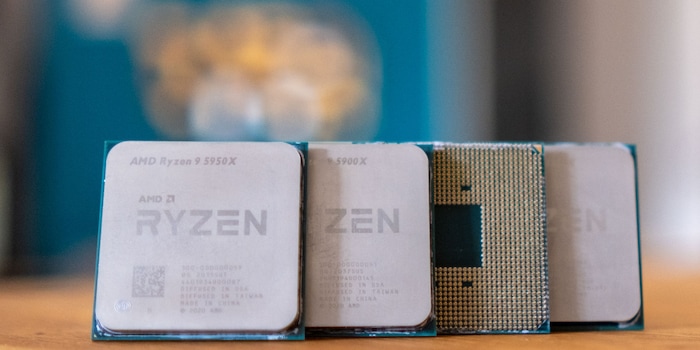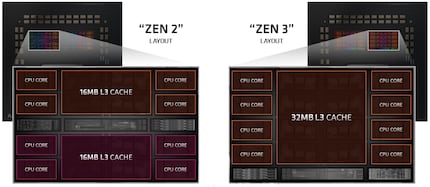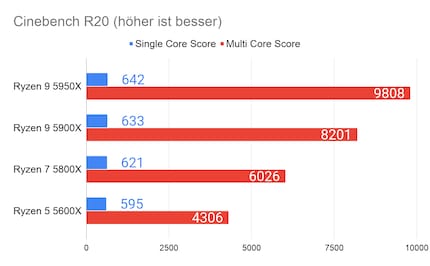
Product test
Ryzen 5 5600X: The new budget gaming CPU?
by Kevin Hofer

With Ryzen, AMD has turned the entire x-86 processor world on its head within three years. More cores, better efficiency and now even better at gaming than competitor Intel. The previous underdog has become the top dog.
It's as if EHC Biel became Swiss ice hockey champions. Or Roger Federer winning a 21st Grand Slam title after all. I can hardly contain my euphoria about the new Ryzen processors. And yet, when I started doing hardware reviews two years ago, I swore I would never get too excited about AMD.
All my PCs since the mid-nineties have run on an AMD processor. I was, am and probably always will be a member of Team Red. As a reviewer, however, I have to be objective and have always been extra hard on AMD to get rid of the fan bonus. I'm doing the same this time, but my euphoria is still justified.
The launch line-up of the Ryzen 5000 series includes the Ryzen 9 5950X and 5900X, the Ryzen 7 5800X and the Ryzen 5 5600X. This means that there is something for beginners, more ambitious users and professionals. By dispensing with a Ryzen 7 5700X, AMD is giving the 5800X more weight. The CPU stood between chairs and benches in the Ryzen 3000 series and had little added value compared to the 3700X. But who knows, maybe AMD will bring something else later on.
| Processor | Microarchitecture / manufacturing process | Cores / Threads | Base / boost clock (GHz) | TDP (Watt) | L3 cache (MB) | PCIe Lanes | Memory Support | Price (as of 05.10.2020) | Price per thread (as of 05.10.2020) |
|---|---|---|---|---|---|---|---|---|---|
| Ryzen 9 5950X | Zen 3 / 7 nm | 16 / 32 | 3,4 / 4,9 | 105 | 64 | 24 Gen4 | Dual-channel DDR4-3200 | 819 | 25,60 |
| Ryzen 9 5900X | Zen 3 / 7 nm | 12 / 24 | 3,7 / 4,8 | 105 | 64 | 24 Gen4 | Dual-channel DDR4-3200 | 549 | 22,90 |
| Ryzen 7 5800X | Zen 3 / 7 nm | 8 / 16 | 3,8 / 4,7 | 105 | 32 | 24 Gen4 | Dual-channel DDR4-3200 | 449 | 28,05 |
| Ryzen 5 5600X | Zen 3 / 7 nm | 6 / 12 | 3,7 / 4,6 | 65 | 32 | 24 Gen4 | Dual-channel DDR4-3200 | 299 | 24,90 |
In addition to this article, I wrote three more for this generation review. You can find the links to detailed reviews of the 5950X, 5900X and 5600X below.
Since I don't have any comparative data for the 5800X - I haven't reviewed the Ryzen 7 3800X or the Intel i7-10700K - I won't write a separate review for this processor. However, so that you also have comparative data for the 5800X, I have of course tested it according to the same criteria as the other Ryzen 5000 processors. You can find these results further down in the article, where I compare the results of all four processors.
At first glance, little has changed compared to the predecessors. With the Ryzen 5000, the performance leap is more in the details. AMD claims to have increased the instructions per cycle (IPC) by up to 19 per cent compared to the previous Zen 2 architecture. Since the introduction of the Zen architecture in 2017, AMD has therefore increased the IPC by a factor of 1.41. In terms of single-thread performance, the Ryzen 9 5950X is 1.68 times more powerful than the Ryzen 7 1800X.
In addition to these increases in IPC and single-thread performance, the Zen 3 microarchitecture brings significant design changes. In contrast to Zen 2, where two Core Complexes (CCX) were located on one Compute Die (CCD), in Zen 3 each CCD consists of one CCX. The structure of Zen 2 is as follows: Each CCX consists of 4 cores and 8 threads as well as 16 MB L3 cache. The CCD of Zen 3 consists of one CCX, which has up to 8 cores and 16 threads as well as 32 MB L3 cache.

The Zen 3 layout enables more efficient core-to-core and core-to-cache connections. This reduces latency, which is particularly noticeable in latency-sensitive applications such as games.
The L2 cache allocations remain unchanged compared to Zen 2 with 512K per core. The same applies to the 12nm I/O die. The 7nm manufacturing process is the same as for the Ryzen 3000XT processors. The processors contain up to two CCDs, resulting in the four processors with 6, 8, 12 and 16 cores.
In contrast to Intel, AMD does not achieve the leap in performance with Zen 3 by increasing the power consumption. The performance per watt of the Ryzen 5000 is around 24 per cent more efficient than the Ryzen 3000, which means that neither the power consumption nor the TDP increases compared to its predecessors. Compared to the i9-10900K from Intel, the Ryzen 9 5900X is even up to 2.8 times more efficient.
You can find the results of the benchmarks of the four CPUs right after this section.

I discuss the results of the 5950X, 5900X and 5600X in detail in the articles linked above. There I compare them with the predecessor models and the competition from Intel. Just this much: Even the smallest processor, the Ryzen 5 5600X, can keep up with the Intel i9-10900K. The leap in performance is enormous, especially in single-thread performance. But the difference is also 20 per cent and more in multi-threaded processes.
With Ryzen 5000, AMD finally leaves Intel behind. Who would have thought that three years ago? Thanks to the consistent further development of the Zen architecture and the Ryzen processors, AMD has achieved this feat. AMD is also charging its customers for this performance: In comparison, all four processors cost more than their predecessors at release. At 20 to 50 francs, this surcharge is kept within reasonable limits. Although the absence of a stock cooler for the 5950X, 5900X and 5600X means there is also a hidden price increase in the package.
AMD is now priced higher than Intel. This is justified by the performance. Intel currently has no choice but to go above the price, as the former top dog currently lacks competitive products. AMD can benefit from this dominance for at least the next few months. As soon as the Ryzen 5000 is more widely available, it will certainly become a little cheaper again, which will only strengthen AMD's advantages.
The next Intel generation, Rocket Lake-S, has only been announced for the first quarter of 2021. Although Intel is finally moving away from the Skylake architecture from 2015, the CPUs are still expected to be manufactured using the 14 nm++ process. In addition, the top model will probably only have 8 cores. This suggests that Intel will primarily focus on single-threaded performance. AMD will then probably have to leave the gaming throne to Intel again. Nevertheless, Intel will have to think about something to keep up with AMD. And I now have to come to terms with the fact that my eternal underdog is now the top dog. If only that were the case with EHC Biel...
We can only hope that Intel will become more competitive again. Because as a consumer, I don't want to put up with another ten years of lethargy and vanity - that's how long Intel's supremacy has lasted. Neither Intel nor AMD can afford that, especially as ARM is also getting stronger and stronger. In the end, it's us consumers who benefit most from this competition.
Update 6 November 2020:
Hello everyone,
Firstly, I understand your frustration that we can't supply enough CPUs for the launch. We would love to have more in stock and supply you all immediately - after all, we want to make money. Unfortunately, this is not possible at the moment. However, we are of course in contact with AMD so that we can have new units available as soon as possible. Please also understand that our colleague Yannick Cejka is currently unable to answer every single e-mail from you immediately. As soon as he has more information, he will inform you as soon as possible on the announcement page
From big data to big brother, Cyborgs to Sci-Fi. All aspects of technology and society fascinate me.